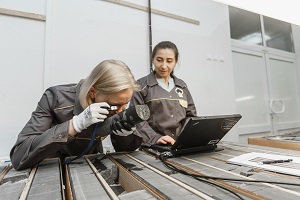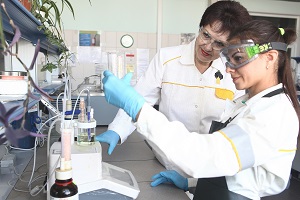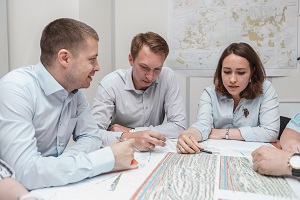Rosneft’s Corporate Scientific and Project Complex Celebrates its 15th Anniversary

The Corporate Scientific and Project Complex of the Company (CSRC) celebrates 15 years since its foundation. Today CSRC Rosneft is the largest oil and gas research center in Europe, which includes 29 design and research institutes, as well as 44 centers of excellence with a total of over 17,000 employees. The aggregate economic effect from the CSRC activity is estimated at more than 150 billion rubles.
CSRC is the basic unit for making scientific and technical decisions in all areas of the Company’s activities: from geological exploration to the sale of petroleum products. The complex provides 100% support for geological operations and provision of design documentation for Rosneft’s production projects.
CSRC provides support for drilling the most difficult horizontal wells (more than 3000 operations annually). In September of this year, construction of a multilateral well with four horizontal bores, which is a record for ancient Riphean sediments, was completed at the Yurubcheno-Tokhomskoye field. The total length of the well was 5,280 m, the horizontal section was 2,220 m. Thanks to the application of an innovative method of seismic geological analysis, during the construction of the well, a drilling efficiency of 99% was achieved. The method was developed by specialists from the Drilling Support Center of the IGiRGI corporate institute. The new approach made it possible to successfully predict multiple tectonic faults, design the well as accurately as possible, and ensure a high well production rate.
 Ensuring information and technological independence of the Company is one of the key tasks of the Complex. CSRC is the operator of all geological and technological information of the Company, the volume of which exceeds 1900 TB of data, and also implements its own information solutions to create digital twins of real objects (more than 70 thousand operations).
Ensuring information and technological independence of the Company is one of the key tasks of the Complex. CSRC is the operator of all geological and technological information of the Company, the volume of which exceeds 1900 TB of data, and also implements its own information solutions to create digital twins of real objects (more than 70 thousand operations).
CSRC has developed and implemented a line of its own science-intensive software in the field of geology, design and monitoring of the development of oil and gas fields. The direct economic effect from the implementation of our own software amounted to more than RUB 1.2 billion.
In particular, CSRC has developed and successfully implemented the first in Eurasia industrial hydraulic fracturing simulator “RN-GRID”, which ensures the execution of all operations and engineering calculations necessary for the design of hydraulic fracturing. To date, using this simulator, specialists of the RN-GRP service company have performed more than ten thousand hydraulic fracturing operations at the Prirazlomnoye field with a full design cycle.
CSRC actively interacts with universities and provides academic licenses of corporate software for the training of qualified young specialists. To date, 210 academic licenses for software products RN-KIN, RN-GRID, RN-KIM, Rospump have been transferred (exclusive rights to the software belong to PJSC NK Rosneft). Such cooperation makes it possible to train qualified specialists both for the Company and for the oil and gas industry of the country as a whole, and allows young specialists, after completing their training, to actively participate in the production process. In addition to the creation of base departments in partner universities, to attract talented specialists, KNPK uses innovative tools, in particular,
 In 2019, for the first time in the history of the Company, a seismic data analysis hackathon “RosneftSeismicChallenge” was held. The championship became one of the world’s largest competition for IT developers for the oil and gas industry, in which 490 teams from 9 countries took part. In 2020, an entire IT competition marathon is planned, which will consist of three events: the Three Cities Hackathon on machine learning, the Hackathon for robotics programmers and the Rosneft Proppant Check Challenge Hackathon (RPCC-2020). The final of the grand IT marathon will take place in November 2020 in Moscow.
In 2019, for the first time in the history of the Company, a seismic data analysis hackathon “RosneftSeismicChallenge” was held. The championship became one of the world’s largest competition for IT developers for the oil and gas industry, in which 490 teams from 9 countries took part. In 2020, an entire IT competition marathon is planned, which will consist of three events: the Three Cities Hackathon on machine learning, the Hackathon for robotics programmers and the Rosneft Proppant Check Challenge Hackathon (RPCC-2020). The final of the grand IT marathon will take place in November 2020 in Moscow.
As part of research activities, the Arctic Scientific Center CSRC organized 26 expeditions, which resulted in the publication of unique ecological atlases: “Kara Sea”, “Laptev Sea” and “Marine mammals of the Russian Arctic and Far East”.
To increase the efficiency of design solutions and the quality of design work, CSRC specialists are introducing the Company’s Typical Design System (STPK). More than 280 standard solutions have been developed, the economic effect of their implementation amounted to more than 36 billion rubles.
Among the most significant technological results of CSRC’s activities in the field of oil refining and petrochemistry, one can single out the creation of its own catalyst for the hydrotreating of diesel fuel, the efficiency of which is higher than imported analogues, the technology for the production of its own oils and additives for class 5 gasoline, as well as the creation of an ultra-light proppant, the use of which in hydraulic fracturing operations. will provide the Company with additional production of more than 1 million tons per year.
Rosneft’s corporate research and design complex performs work not only for the subsidiaries of the Company, but also for third-party customers. Currently, the portfolio of CSRC customers is more than 100 organizations. The growth in the number of external orders increases the economic efficiency of the Complex for the Company, and also contributes to the strengthening of the international authority and image of PJSC NK Rosneft as a technology leader.
Building competencies and entering the external, including the international market is one of the priorities of the CPPK. Today, Rosneft has three joint ventures with leading foreign companies in the field of scientific and technical cooperation, including the design and creation of special equipment, as well as the design of oil production and processing facilities using 3D modeling methods. In the field of information technology, CSRC actively cooperates with leading companies in the field of applied software for geology and field development. In the near future, their number in key areas of activity will increase.










